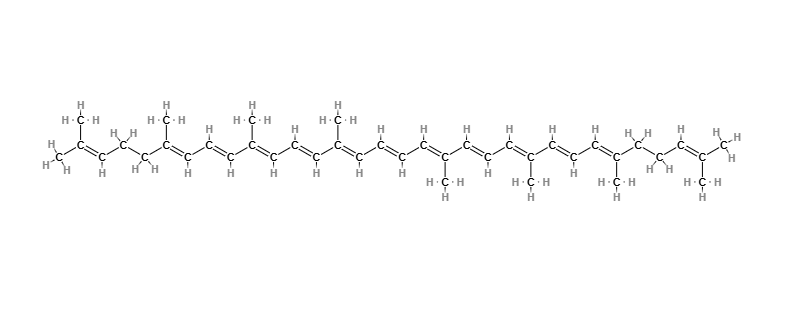| "Descrizione" by FRanier (9971 pt) | 2024-May-28 16:48 |
Review Consensus: 8 Rating: 8 Number of users: 1
| Evaluation | N. Experts | Evaluation | N. Experts |
|---|---|---|---|
| 1 | 6 | ||
| 2 | 7 | ||
| 3 | 8 | ||
| 4 | 9 | ||
| 5 | 10 |
Lycopene is a colouring agent derived from the carotenoid lycopene, which is found in fruits and vegetables and is used to impart colour.
Industrial Production Process
- Preparation of reagents. The main raw materials include natural sources rich in carotenoids, such as algae, carrots, or palm fruits, and organic solvents such as ethanol or hexane.
- Harvesting and cleaning. The raw materials are harvested and cleaned to remove impurities and debris.
- Drying. The cleaned raw materials are dried at controlled temperatures to reduce moisture content and facilitate carotenoid extraction.
- Extraction. The dried raw materials are treated with a suitable solvent (ethanol, hexane, or a solvent mixture) to extract the carotenoid compounds. Extraction can be done through maceration, infusion, or solvent extraction.
- Filtration. The extracted mixture is filtered to remove solid residues and obtain a clear coloring solution.
- Concentration. The coloring solution is concentrated through vacuum evaporation to reduce the volume and increase the concentration of carotenoids.
- Purification. The concentrated solution may be further purified using techniques such as chromatography to remove unwanted impurities and improve the color quality.
- Stabilization. The purified coloring is stabilized with antioxidants like BHT (butylated hydroxytoluene) to prevent oxidation and maintain color stability during transportation and storage.
- Drying. The purified product is dried at controlled temperatures to obtain a fine carotenoid powder.
- Quality control. Lycopene undergoes rigorous quality testing to ensure it meets standards for purity, color intensity, and safety. These tests include chemical analysis, spectroscopy, and microbiological testing.
What it is used for and where
Medical
In this study on carotenoids, a list of fruit and vegetables and the percentages they contain (1).
Lycopene possesses antioxidant and anti-cancer properties (2).
Food
In the food industry, it is a chemical compound, an ingredient listed in the European Food Additives List as E160d and in the Colour Index International as CI 75125. It is a synthetic colouring agent with carotenoids (fat-soluble organic pigments responsible for the colouring of different fruits and vegetables) and is also known as Natural Yellow 27.
Cosmetics
Restricted cosmetic ingredient as IV/110 a Relevant Item in the Annexes of the European Cosmetics Regulation 1223/2009. Substance or ingredient reported:
- Lycopene. Wording of conditions of use and warnings Purity criteria as set out in Commission Directive 95/45/EC (E 160d)
Colouring agent. This ingredient has the primary function of colouring the solution in which it is inserted in a temporary, semi-permanent or permanent manner, either alone or in the presence of the complementary components added for colouring.
Safety. It is an ingredient considered safe
 |  |
Molecular Formula: C40H56
Molecular Weight: 536.888
CAS: 502-65-8
EC number 207-949-1
UNII SB0N2N0WV6
DTXSID2046593
Synonyms:
E160d
Lycopene
Lycored
Redivivo
References___________________________________________________________________
(1) Sommerburg O, Keunen JE, Bird AC, van Kuijk FJ. Fruits and vegetables that are sources for lutein and zeaxanthin: the macular pigment in human eyes. Br J Ophthalmol. 1998 Aug;82(8):907-10. doi: 10.1136/bjo.82.8.907.
Abstract. Background: It has been suggested that eating green leafy vegetables, which are rich in lutein and zeaxanthin, may decrease the risk for age related macular degeneration. The goal of this study was to analyse various fruits and vegetables to establish which ones contain lutein and/or zeaxanthin and can serve as possible dietary supplements for these carotenoids....Conclusions: Most of the dark green leafy vegetables, previously recommended for a higher intake of lutein and zeaxanthin, have 15-47% of lutein, but a very low content (0-3%) of zeaxanthin. Our study shows that fruits and vegetables of various colours can be consumed to increase dietary intake of lutein and zeaxanthin.
(2) Lycopene Inhibits Activation of Epidermal Growth Factor Receptor and Expression of Cyclooxygenase-2 in Gastric Cancer Cells. Han H, Lim JW, Kim H. Nutrients. 2019 Sep 5;11(9). pii: E2113. doi: 10.3390/nu11092113.
Abstract. Reactive oxygen species (ROS) contribute to the oncogenic phenotype of cancer cells by acting as signaling molecules for inducing proliferation. ROS are known to activate the epidermal growth factor receptor (EGFR), which causes the activation of the Ras/mitogen-activated protein kinases (MAPKs) pathway. The Ras-dependent pathway promotes the activation of nuclear factor-kappa-light-chain-enhancer of activated B cells (NF-κB), a transcriptional modulator of cyclooxygenase-2 (COX-2) that induces cell proliferation. Lycopene is a potent antioxidant carotenoid and is responsible for the red color of fruits and vegetables. This study aims to investigate whether lycopene inhibits proliferation and induces apoptosis in gastric cancer AGS cells by suppressing the EGFR/Ras/MAPK and NF-κB-COX-2 signaling axis. Lycopene decreased cell viability and increased apoptotic indices (DNA fragmentation, apoptosis inducing factor, cleavage of caspase-3 and caspase-9, Bax/Bcl-2 ratio). Lycopene reduced the level of intracellular and mitochondrial ROS and decreased the activation of the ROS-mediated EGFR/Ras/extracellular signal-regulated kinase (ERK) and p38 MAPK pathways, thus leading to attenuation of the DNA-binding activity of NF-κB p50/p50 and the level of COX-2 gene expression. These results show that lycopene-induced apoptosis and inhibition of proliferation occur via inhibition of ROS-activated EGFR/Ras/ERK and p38 MAPK pathways and NF-κB-mediated COX-2 gene expression in AGS cells. In conclusion, consumption of lycopene-enriched foods could decrease the incidence of gastric cancer.
| Evaluate |

